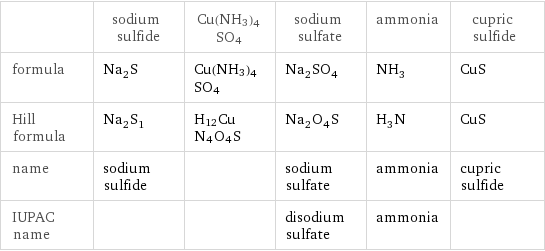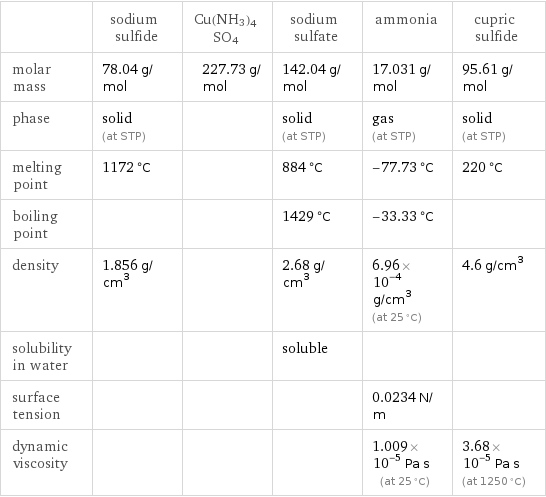Input interpretation

Na_2S sodium sulfide + Cu(NH3)4SO4 ⟶ Na_2SO_4 sodium sulfate + NH_3 ammonia + CuS cupric sulfide
Balanced equation

Balance the chemical equation algebraically: Na_2S + Cu(NH3)4SO4 ⟶ Na_2SO_4 + NH_3 + CuS Add stoichiometric coefficients, c_i, to the reactants and products: c_1 Na_2S + c_2 Cu(NH3)4SO4 ⟶ c_3 Na_2SO_4 + c_4 NH_3 + c_5 CuS Set the number of atoms in the reactants equal to the number of atoms in the products for Na, S, Cu, N, H and O: Na: | 2 c_1 = 2 c_3 S: | c_1 + c_2 = c_3 + c_5 Cu: | c_2 = c_5 N: | 4 c_2 = c_4 H: | 12 c_2 = 3 c_4 O: | 4 c_2 = 4 c_3 Since the coefficients are relative quantities and underdetermined, choose a coefficient to set arbitrarily. To keep the coefficients small, the arbitrary value is ordinarily one. For instance, set c_1 = 1 and solve the system of equations for the remaining coefficients: c_1 = 1 c_2 = 1 c_3 = 1 c_4 = 4 c_5 = 1 Substitute the coefficients into the chemical reaction to obtain the balanced equation: Answer: | | Na_2S + Cu(NH3)4SO4 ⟶ Na_2SO_4 + 4 NH_3 + CuS
Structures

+ Cu(NH3)4SO4 ⟶ + +
Names

sodium sulfide + Cu(NH3)4SO4 ⟶ sodium sulfate + ammonia + cupric sulfide
Equilibrium constant
![Construct the equilibrium constant, K, expression for: Na_2S + Cu(NH3)4SO4 ⟶ Na_2SO_4 + NH_3 + CuS Plan: • Balance the chemical equation. • Determine the stoichiometric numbers. • Assemble the activity expression for each chemical species. • Use the activity expressions to build the equilibrium constant expression. Write the balanced chemical equation: Na_2S + Cu(NH3)4SO4 ⟶ Na_2SO_4 + 4 NH_3 + CuS Assign stoichiometric numbers, ν_i, using the stoichiometric coefficients, c_i, from the balanced chemical equation in the following manner: ν_i = -c_i for reactants and ν_i = c_i for products: chemical species | c_i | ν_i Na_2S | 1 | -1 Cu(NH3)4SO4 | 1 | -1 Na_2SO_4 | 1 | 1 NH_3 | 4 | 4 CuS | 1 | 1 Assemble the activity expressions accounting for the state of matter and ν_i: chemical species | c_i | ν_i | activity expression Na_2S | 1 | -1 | ([Na2S])^(-1) Cu(NH3)4SO4 | 1 | -1 | ([Cu(NH3)4SO4])^(-1) Na_2SO_4 | 1 | 1 | [Na2SO4] NH_3 | 4 | 4 | ([NH3])^4 CuS | 1 | 1 | [CuS] The equilibrium constant symbol in the concentration basis is: K_c Mulitply the activity expressions to arrive at the K_c expression: Answer: | | K_c = ([Na2S])^(-1) ([Cu(NH3)4SO4])^(-1) [Na2SO4] ([NH3])^4 [CuS] = ([Na2SO4] ([NH3])^4 [CuS])/([Na2S] [Cu(NH3)4SO4])](../image_source/4aafec58bc59284828f8d4ab810db8ec.png)
Construct the equilibrium constant, K, expression for: Na_2S + Cu(NH3)4SO4 ⟶ Na_2SO_4 + NH_3 + CuS Plan: • Balance the chemical equation. • Determine the stoichiometric numbers. • Assemble the activity expression for each chemical species. • Use the activity expressions to build the equilibrium constant expression. Write the balanced chemical equation: Na_2S + Cu(NH3)4SO4 ⟶ Na_2SO_4 + 4 NH_3 + CuS Assign stoichiometric numbers, ν_i, using the stoichiometric coefficients, c_i, from the balanced chemical equation in the following manner: ν_i = -c_i for reactants and ν_i = c_i for products: chemical species | c_i | ν_i Na_2S | 1 | -1 Cu(NH3)4SO4 | 1 | -1 Na_2SO_4 | 1 | 1 NH_3 | 4 | 4 CuS | 1 | 1 Assemble the activity expressions accounting for the state of matter and ν_i: chemical species | c_i | ν_i | activity expression Na_2S | 1 | -1 | ([Na2S])^(-1) Cu(NH3)4SO4 | 1 | -1 | ([Cu(NH3)4SO4])^(-1) Na_2SO_4 | 1 | 1 | [Na2SO4] NH_3 | 4 | 4 | ([NH3])^4 CuS | 1 | 1 | [CuS] The equilibrium constant symbol in the concentration basis is: K_c Mulitply the activity expressions to arrive at the K_c expression: Answer: | | K_c = ([Na2S])^(-1) ([Cu(NH3)4SO4])^(-1) [Na2SO4] ([NH3])^4 [CuS] = ([Na2SO4] ([NH3])^4 [CuS])/([Na2S] [Cu(NH3)4SO4])
Rate of reaction
![Construct the rate of reaction expression for: Na_2S + Cu(NH3)4SO4 ⟶ Na_2SO_4 + NH_3 + CuS Plan: • Balance the chemical equation. • Determine the stoichiometric numbers. • Assemble the rate term for each chemical species. • Write the rate of reaction expression. Write the balanced chemical equation: Na_2S + Cu(NH3)4SO4 ⟶ Na_2SO_4 + 4 NH_3 + CuS Assign stoichiometric numbers, ν_i, using the stoichiometric coefficients, c_i, from the balanced chemical equation in the following manner: ν_i = -c_i for reactants and ν_i = c_i for products: chemical species | c_i | ν_i Na_2S | 1 | -1 Cu(NH3)4SO4 | 1 | -1 Na_2SO_4 | 1 | 1 NH_3 | 4 | 4 CuS | 1 | 1 The rate term for each chemical species, B_i, is 1/ν_i(Δ[B_i])/(Δt) where [B_i] is the amount concentration and t is time: chemical species | c_i | ν_i | rate term Na_2S | 1 | -1 | -(Δ[Na2S])/(Δt) Cu(NH3)4SO4 | 1 | -1 | -(Δ[Cu(NH3)4SO4])/(Δt) Na_2SO_4 | 1 | 1 | (Δ[Na2SO4])/(Δt) NH_3 | 4 | 4 | 1/4 (Δ[NH3])/(Δt) CuS | 1 | 1 | (Δ[CuS])/(Δt) (for infinitesimal rate of change, replace Δ with d) Set the rate terms equal to each other to arrive at the rate expression: Answer: | | rate = -(Δ[Na2S])/(Δt) = -(Δ[Cu(NH3)4SO4])/(Δt) = (Δ[Na2SO4])/(Δt) = 1/4 (Δ[NH3])/(Δt) = (Δ[CuS])/(Δt) (assuming constant volume and no accumulation of intermediates or side products)](../image_source/f475e29e37b5f86dbab1b7d2fa962284.png)
Construct the rate of reaction expression for: Na_2S + Cu(NH3)4SO4 ⟶ Na_2SO_4 + NH_3 + CuS Plan: • Balance the chemical equation. • Determine the stoichiometric numbers. • Assemble the rate term for each chemical species. • Write the rate of reaction expression. Write the balanced chemical equation: Na_2S + Cu(NH3)4SO4 ⟶ Na_2SO_4 + 4 NH_3 + CuS Assign stoichiometric numbers, ν_i, using the stoichiometric coefficients, c_i, from the balanced chemical equation in the following manner: ν_i = -c_i for reactants and ν_i = c_i for products: chemical species | c_i | ν_i Na_2S | 1 | -1 Cu(NH3)4SO4 | 1 | -1 Na_2SO_4 | 1 | 1 NH_3 | 4 | 4 CuS | 1 | 1 The rate term for each chemical species, B_i, is 1/ν_i(Δ[B_i])/(Δt) where [B_i] is the amount concentration and t is time: chemical species | c_i | ν_i | rate term Na_2S | 1 | -1 | -(Δ[Na2S])/(Δt) Cu(NH3)4SO4 | 1 | -1 | -(Δ[Cu(NH3)4SO4])/(Δt) Na_2SO_4 | 1 | 1 | (Δ[Na2SO4])/(Δt) NH_3 | 4 | 4 | 1/4 (Δ[NH3])/(Δt) CuS | 1 | 1 | (Δ[CuS])/(Δt) (for infinitesimal rate of change, replace Δ with d) Set the rate terms equal to each other to arrive at the rate expression: Answer: | | rate = -(Δ[Na2S])/(Δt) = -(Δ[Cu(NH3)4SO4])/(Δt) = (Δ[Na2SO4])/(Δt) = 1/4 (Δ[NH3])/(Δt) = (Δ[CuS])/(Δt) (assuming constant volume and no accumulation of intermediates or side products)
Chemical names and formulas

| sodium sulfide | Cu(NH3)4SO4 | sodium sulfate | ammonia | cupric sulfide formula | Na_2S | Cu(NH3)4SO4 | Na_2SO_4 | NH_3 | CuS Hill formula | Na_2S_1 | H12CuN4O4S | Na_2O_4S | H_3N | CuS name | sodium sulfide | | sodium sulfate | ammonia | cupric sulfide IUPAC name | | | disodium sulfate | ammonia |
Substance properties

| sodium sulfide | Cu(NH3)4SO4 | sodium sulfate | ammonia | cupric sulfide molar mass | 78.04 g/mol | 227.73 g/mol | 142.04 g/mol | 17.031 g/mol | 95.61 g/mol phase | solid (at STP) | | solid (at STP) | gas (at STP) | solid (at STP) melting point | 1172 °C | | 884 °C | -77.73 °C | 220 °C boiling point | | | 1429 °C | -33.33 °C | density | 1.856 g/cm^3 | | 2.68 g/cm^3 | 6.96×10^-4 g/cm^3 (at 25 °C) | 4.6 g/cm^3 solubility in water | | | soluble | | surface tension | | | | 0.0234 N/m | dynamic viscosity | | | | 1.009×10^-5 Pa s (at 25 °C) | 3.68×10^-5 Pa s (at 1250 °C)
Units
